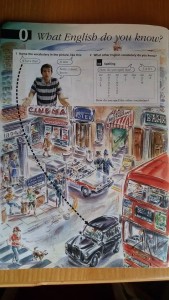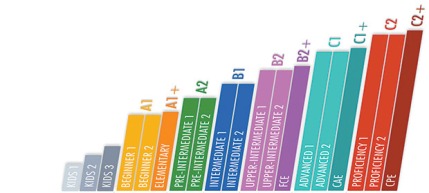LET’S STUDY POSSESSIVE ADJECTIVES/PRONOUNS
IRREGULAR VERBS
VERB TO BE – ARTICLES
Europass – European language levels – Self Assessment Grid
Europass – European language levels ITA – Self Assessment Grid (1)
What is the first thing you do every morning? (open link)
Video Quiz
Answer the following questions about the video.
1) What does Erina do first in the morning?
- a) She turns on the heater
- b) She takes a drink of water
2) Erina’s room is _____ .
- a) cold
- b) warm
3) Erina takes a _____ .
- a) bath
- b) shower
FIRST BEGINNERS’ LESSON (adjectives, italinglish, spelling..)
Pronunciation Guide for English Dictionary
Pronunciation Guide for English Dictionary
Pronunciation Guide for English Dictionary
This guide will help you to understand and use the pronunciation symbols found in this dictionary.
The British pronunciations given are those of younger speakers of General British. This includes RP (Received Pronunciation) and a range of similar accents which are not strongly regional. The American pronunciations chosen are also as far as possible the most general (not associated with any particular region). In dictionary entries, the British pronunciation is given first.
Consonants
| p | pen | /pen/ |
| b | bad | /bæd/ |
| t | tea | /tiː/ |
| d | did | /dɪd/ |
| k | cat | /kæt/ |
| ɡ | get | /ɡet/ |
| tʃ | chain | /tʃeɪn/ |
| dʒ | jam | /dʒæm/ |
| f | fall | /fɔːl/ |
| v | van | /væn/ |
| θ | thin | /θɪn/ |
| ð | this | /ðɪs/ |
| s | see | /siː/ |
| z | zoo | /zuː/ |
| ʃ | shoe | /ʃuː/ |
| ʒ | vision | /ˈvɪʒn/ |
| h | hat | /hæt/ |
| m | man | /mæn/ |
| n | now | /naʊ/ |
| ŋ | sing | /sɪŋ/ |
| l | leg | /leɡ/ |
| r | red | /red/ |
| j | yes | /jes/ |
| w | wet | /wet/ |
The symbol (r) indicates that British pronunciation will have /r/ only if a vowel sound follows directly at the beginning of the next word, as in far away; otherwise the /r/ is omitted. For American English, all the /r/ sounds should be pronounced.
/x/ represents a fricative sound as in /lɒx/ for Scottish loch, Irish lough.
Vowels and diphthongs
| iː | see | /siː/ |
| i | happy | /ˈhæpi/ |
| ɪ | sit | /sɪt/ |
| e | ten | /ten/ |
| æ | cat | /kæt/ |
| ɑː | father | /ˈfɑːðə(r)/ |
| ɒ | got | /ɡɒt/ (British English) |
| ɔː | saw | /sɔː/ |
| ʊ | put | /pʊt/ |
| u | actual | /ˈæktʃuəl/ |
| uː | too | /tuː/ |
| ʌ | cup | /kʌp/ |
| ɜː | fur | /fɜː(r)/ |
| ə | about | /əˈbaʊt/ |
| eɪ | say | /seɪ/ |
| əʊ | go | /ɡəʊ/ (British English) |
| oʊ | go | /ɡoʊ/ (American English) |
| aɪ | my | /maɪ/ |
| ɔɪ | boy | /bɔɪ/ |
| aʊ | now | /naʊ/ |
| ɪə | near | /nɪə(r)/ (British English) |
| eə | hair | /heə(r)/ (British English) |
| ʊə | pure | /pjʊə(r)/ (British English) |
Nasalized vowels, marked with /~/, may be retained in certain words taken from French, as in penchant /ˈpɒ̃ʃɒ̃/ and coq au vin / ˌkɒk əʊ ˈvæ̃/.
Syllabic consonants
The sounds /l/ and /n/ can often be “syllabic” – that is, they can form a syllable by themselves without a vowel. There is a syllabic / l/ in the usual pronunciation of middle / ˈmɪdl/, and a syllabic /n/ in sudden /ˈsʌdn/.
Weak vowels /i/ and /u/
The sounds represented by /iː/ and / ɪ/ must always be made different, as in heat /hiːt/ compared with hit /hɪt/. The symbol /i/ represents a vowel that can be sounded as either /iː/ or /ɪ/, or as a sound which is a compromise between them. In a word such as happy /ˈhæpi/, younger speakers use a quality more like /iː/, but short in duration. When /i/ is followed by /ə/ the sequence can also be pronounced / jə/. So the worddubious can be /ˈdjuːbiəs / or /ˈdjuːbjəs/. In the same way, the two vowels represented /uː/ and /ʊ/ must be kept distinct but /u/ represents a weak vowel that varies between them. If /u/ is followed directly by a consonant sound, it can also be pronounced as /ə/. So stimulate can be /ˈstɪmjuleɪt/ or /ˈstɪmjəleɪt/.
Weak forms and strong forms
Certain very common words, for example at, for, and can, have two pronunciations. We give the usual (weak) pronunciation first. The second pronunciation (strong) must be used if the word is stressed, and also generally when the word is at the end of a sentence. For example:
- Can /kən/ you help?
- I’ll help if I can /kæn/.
Tapping of / t /
In American English, if a /t/ sound is between two vowels, and the second vowel is not stressed, the /t / can be pronounced very quickly, and made voiced so that it is like a brief /d/ or the r-sound of certain languages. Technically, the sound is a “tap”, and can be symbolised by /t̬/. So Americans can pronouncepotato as /pəˈteɪt̬oʊ/, tapping the second /t/ in the word (but not the first, because of the stress). British speakers don’t generally do this.
The conditions for tapping also arise very frequently when words are put together, as in not only, what I, etc. In this case it doesn’t matter whether the following vowel is stressed or not, and even British speakers can use taps in this situation, though they sound rather casual.
The glottal stop
In both British and American varieties of English, a /t/ which comes at the end of a word or syllable can often be pronounced as a glottal stop /ʔ/ (a silent gap produced by holding one’s breath briefly) instead of a /t/. For this to happen, the next sound must not be a vowel or a syllabic /l/.
So football can be /ˈfʊʔbɔːl/ instead of /ˈfʊtbɔːl/, and button can be /ˈbʌʔn/ instead of /ˈbʌtn/.
But a glottal stop would not be used for the /t/ sounds in bottle or better because of the sounds which come afterwards.
Which is your level of English?
A – Base
A1 – (Breakthrough)
Comprende e usa espressioni di uso quotidiano e frasi basilari tese a soddisfare bisogni di tipo concreto. Sa presentare se stesso/a e gli altri ed è in grado di fare domande e rispondere su particolari personali come dove abita, le persone che conosce e le cose che possiede. Interagisce in modo semplice, purché l’altra persona parli lentamente e chiaramente e sia disposta a collaborare.
A2 – (Waystage)
Comprende frasi ed espressioni usate frequentemente relative ad ambiti di immediata rilevanza (es. informazioni personali e familiari di base, fare la spesa, la geografia locale, l’occupazione). Comunica in attività semplici e di abitudine che richiedono un semplice scambio di informazioni su argomenti familiari e comuni. Sa descrivere in termini semplici aspetti della sua vita, dell’ambiente circostante; sa esprimere bisogni immediati.
B – Autonomia
B1 – (Threshold )
Comprende i punti chiave di argomenti familiari che riguardano la scuola, il tempo libero ecc. Sa muoversi con disinvoltura in situazioni che possono verificarsi mentre viaggia nel paese di cui parla la lingua. È in grado di produrre un testo semplice relativo ad argomenti che siano familiari o di interesse personale. È in grado di esprimere esperienze ed avvenimenti, sogni, speranze e ambizioni e di spiegare brevemente le ragioni delle sue opinioni e dei suoi progetti.
B2 – (Vantage)
Comprende le idee principali di testi complessi su argomenti sia concreti che astratti, comprese le discussioni tecniche sul suo campo di specializzazione. È in grado di interagire con una certa scioltezza e spontaneità che rendono possibile una interazione naturale con i parlanti nativi senza sforzo per l’interlocutore. Sa produrre un testo chiaro e dettagliato su un’ampia gamma di argomenti e spiegare un punto di vista su un argomento fornendo i pro e i contro delle varie opzioni.
C – Padronanza
C1 – (Effective Operational Proficiency)
Comprende un’ampia gamma di testi complessi e lunghi e ne sa riconoscere il significato implicito. Si esprime con scioltezza e naturalezza. Usa la lingua in modo flessibile ed efficace per scopi sociali, professionali ed accademici. Riesce a produrre testi chiari, ben costruiti, dettagliati su argomenti complessi, mostrando un sicuro controllo della struttura testuale, dei connettori e degli elementi di coesione.
C2 – (Mastery)
Comprende con facilità praticamente tutto ciò che sente e legge. Sa riassumere informazioni provenienti da diverse fonti sia parlate che scritte, ristrutturando gli argomenti in una presentazione coerente. Sa esprimersi spontaneamente, in modo molto scorrevole e preciso, individuando le più sottili sfumature di significato in situazioni complesse.
The texting hat
Super!
Note : All Viralelt posts share the same structure. Teacher’s notes appear only on How to use Viralelt. This is done to keep “teacher text” to a minimum and avoid repetition.
- Do you think it’s rude to check your phone when you are with other people? Does this depend onwho you are talking to, or how many people you are with?
- How do you feel and react when you are having a conversation with somebody and they start checking their phone?
- Is it more acceptableto interrupt a face-to-face conversation when you get a phone call, or when you get a social media notification? Do you think attitudes todifferent types of interruption are changing?
- Do you ever feel that interacting withyour phone is more interesting and enjoyable than being in the company ofthe people around you?
- Do you reply to text…
View original post 215 more words
Integrating video content in the EFL classroom with International Express – Part 1
 EFL teacher, teacher trainer and Principal of St. Giles International, Keith Harding has authored and co-authored several courses published by Oxford University Press. To mark the release of stunning new video material for International Express, Keith Harding and Rachel Appleby have prepared a series of four articles to be used alongside units within the course. Today, Keith shares some ideas and video resources for Elementary Unit 6 – Santiago, Chile, focusing on comparative and superlative adjectives.
EFL teacher, teacher trainer and Principal of St. Giles International, Keith Harding has authored and co-authored several courses published by Oxford University Press. To mark the release of stunning new video material for International Express, Keith Harding and Rachel Appleby have prepared a series of four articles to be used alongside units within the course. Today, Keith shares some ideas and video resources for Elementary Unit 6 – Santiago, Chile, focusing on comparative and superlative adjectives.
The introduction of video as a learning medium in the classroom needn’t mean passive learning, or a risk of students ‘switching off’ from being engaged. The key to maximising learning potential, as with any listening or reading text, is to prepare and predict.
Before watching:
Here are some ideas for preparatory work, before watching the video:
- Countries and cities
- Show the picture of Santiago from the video as a still image.
- Where is…
View original post 583 more words







